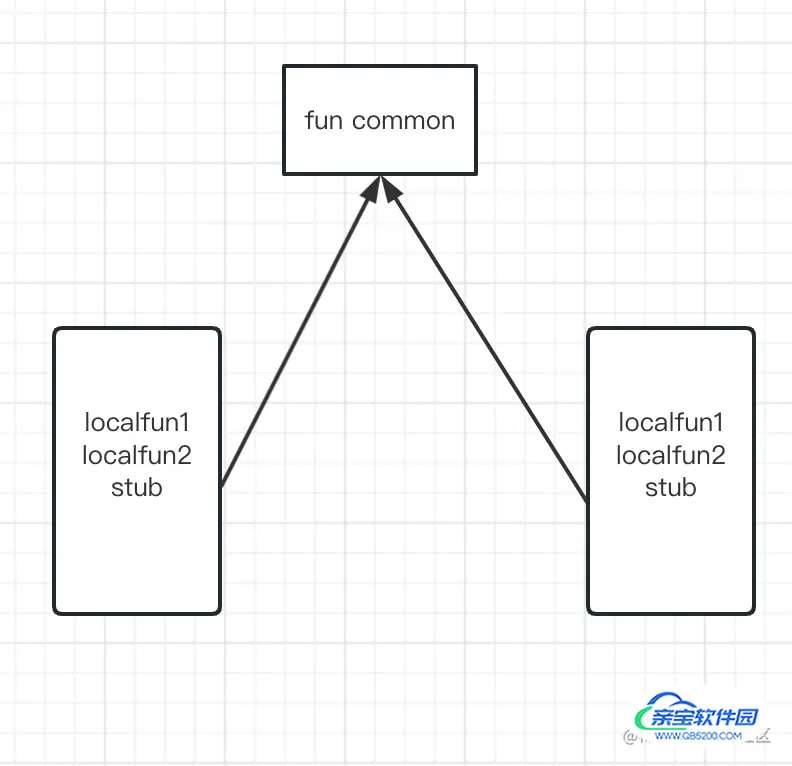so加载Linker跟NameSpace机制详解
Pika 人气:0前言
so库的加载可是我们日常开发都会用到的,因此系统也提供了非常方便的api给我们进行调用
System.loadLibrary(xxxso);
当然,随着版本的变化,loadLibrary也是出现了非常大的变化,最重要的是分水岭是androidN加入了namespace机制,可能很多人都是一头雾水噢!这是个啥?我们在动态so加载方案中,会频繁出现这个名词,同时还有一个高频的词就是Linker,本期不涉及复杂的技术方案,我们就来深入聊聊,Linker的概念,与namespace机制的加入,希望能帮助更多开发者去了解so的加载过程。
Linker
我们都知道,Linux平台下有动态链接文件(.so)与静态链接文件(.a),两者其实都是一种ELF文件(相关的文件格式我们不赘述)。为什么会有这么两种文件呢?我们就从简单的角度来想一次,其实就是为了更多的代码复用,比如程序1,程序2都用到了同一个东西,比如xx.so

此时就会出现,程序1与程序2中调用fun common的地方,在没有链接之前,调用处的地址,我们以“stub”,表示这其实是一个未确定的东西,而后续的这个地址填充(写入正确的common地址),其实就是Linker的职责。
我们通过上面的例子,其实就可以明白,Linker,主要的职责,就是帮助查找当前程序所依赖的动态库文件(ELF文件)。那么Linker本身是个什么呢,其实他跟.so文件都是同一种格式,也是ELF文件,那么Linker又由谁帮助加载启动呢,这里就会出现存在一个(鸡生蛋,蛋生鸡)的问题,而ELF文件给出的答案就是,设立一个:interp 的段,当一个进程启动的时候(linux中通过execv启动),此时就会通过load_elf_binary函数,先加载ELF文件,然后再调用load_elf_interp方法,直接加载了:interp 段地址的起点,从而能够构建我们的大管家Linker,当然,Linker本身就不能像普通的so文件一样,去依赖另一个so,其实原因也很简单,没人帮他初始化呀!因此Linker是采用配置的方式先启动起来了!
当然,我们主要的目标是建立概念,Linker本身涉及的复杂加载,我们也不继续贴出来了
NameSpace
在以往的anroidN以下版本中,加载so库通常是直接采用dlopen的方式去直接加载的,对于非公开的符号,如果被使用,就容易在之后迭代出现问题,(类似java,使用了一个三方库的private方法,如果后续变更方法含义,就会出现问题),因此引入了NameSpace机制
Android 7.0 为原生库引入了命名空间,以限制内部 API 可见性并解决应用意外使用平台库而不是自己的平台库的情况。
我们说的NameSpace,主要对应着一个数据结构android_namespace_link_t
linker_namespaces.h
struct android_namespace_link_t
private:
std::string name_; namespace名称
bool is_isolated_; 是否隔离(大部分是true)
std::vector<std::string> ld_library_paths_; 链接路径
std::vector<std::string> default_library_paths_;默认可访问路径
std::vector<std::string> permitted_paths_;已允许访问路径
....
我们来看一看,这个数据结构在哪里会被使用到,其实就是so库加载过程。当我们调用System.loadLibrary的时候,其实最终调用的是
private synchronized void loadLibrary0(ClassLoader loader, Class<?> callerClass, String libname) {
文件名校验
if (libname.indexOf((int)File.separatorChar) != -1) {
throw new UnsatisfiedLinkError(
"Directory separator should not appear in library name: " + libname);
}
String libraryName = libname;
// Android-note: BootClassLoader doesn't implement findLibrary(). http://b/111850480
// Android's class.getClassLoader() can return BootClassLoader where the RI would
// have returned null; therefore we treat BootClassLoader the same as null here.
if (loader != null && !(loader instanceof BootClassLoader)) {
String filename = loader.findLibrary(libraryName);
if (filename == null &&
(loader.getClass() == PathClassLoader.class ||
loader.getClass() == DelegateLastClassLoader.class)) {
// Don't give up even if we failed to find the library in the native lib paths.
// The underlying dynamic linker might be able to find the lib in one of the linker
// namespaces associated with the current linker namespace. In order to give the
// dynamic linker a chance, proceed to load the library with its soname, which
// is the fileName.
// Note that we do this only for PathClassLoader and DelegateLastClassLoader to
// minimize the scope of this behavioral change as much as possible, which might
// cause problem like b/143649498. These two class loaders are the only
// platform-provided class loaders that can load apps. See the classLoader attribute
// of the application tag in app manifest.
filename = System.mapLibraryName(libraryName);
}
if (filename == null) {
// It's not necessarily true that the ClassLoader used
// System.mapLibraryName, but the default setup does, and it's
// misleading to say we didn't find "libMyLibrary.so" when we
// actually searched for "liblibMyLibrary.so.so".
throw new UnsatisfiedLinkError(loader + " couldn't find "" +
System.mapLibraryName(libraryName) + """);
}
String error = nativeLoad(filename, loader);
if (error != null) {
throw new UnsatisfiedLinkError(error);
}
return;
}
// We know some apps use mLibPaths directly, potentially assuming it's not null.
// Initialize it here to make sure apps see a non-null value.
getLibPaths();
String filename = System.mapLibraryName(libraryName);
//最终调用nativeLoad
String error = nativeLoad(filename, loader, callerClass);
if (error != null) {
throw new UnsatisfiedLinkError(error);
}
}
这里我们注意到,抛出UnsatisfiedLinkError的时机,要么so文件名加载不合法,要么就是nativeLoad方法返回了错误信息,这里是需要我们注意的,我们如果出现这个异常,可以从这里排查,nativeLoad方法最终通过LoadNativeLibrary,在native层真正进入so的加载过程
LoadNativeLibrary 非常长,我们截取部分
bool JavaVMExt::LoadNativeLibrary(JNIEnv* env,
const std::string& path,
jobject class_loader,
jclass caller_class,
std::string* error_msg) {
会判断是否已经加载过当前so,同时也要加锁,因为存在多线程加载的情况
SharedLibrary* library;
Thread* self = Thread::Current();
{
// TODO: move the locking (and more of this logic) into Libraries.
MutexLock mu(self, *Locks::jni_libraries_lock_);
library = libraries_->Get(path);
}
调用OpenNativeLibrary加载
void* handle = android::OpenNativeLibrary(
env,
runtime_->GetTargetSdkVersion(),
path_str,
class_loader,
(caller_location.empty() ? nullptr : caller_location.c_str()),
library_path.get(),
&needs_native_bridge,
&nativeloader_error_msg);
这里又是漫长的native方法,OpenNativeLibrary,在这里我们终于见到namespace了
void* OpenNativeLibrary(JNIEnv* env, int32_t target_sdk_version, const char* path,
jobject class_loader, const char* caller_location, jstring library_path,
bool* needs_native_bridge, char** error_msg) {
#if defined(ART_TARGET_ANDROID)
UNUSED(target_sdk_version);
if (class_loader == nullptr) {
*needs_native_bridge = false;
if (caller_location != nullptr) {
android_namespace_t* boot_namespace = FindExportedNamespace(caller_location);
if (boot_namespace != nullptr) {
const android_dlextinfo dlextinfo = {
.flags = ANDROID_DLEXT_USE_NAMESPACE,
.library_namespace = boot_namespace,
};
//最终调用android_dlopen_ext打开
void* handle = android_dlopen_ext(path, RTLD_NOW, &dlextinfo);
if (handle == nullptr) {
*error_msg = strdup(dlerror());
}
return handle;
}
}
// Check if the library is in NATIVELOADER_DEFAULT_NAMESPACE_LIBS and should
// be loaded from the kNativeloaderExtraLibs namespace.
{
Result<void*> handle = TryLoadNativeloaderExtraLib(path);
if (!handle.ok()) {
*error_msg = strdup(handle.error().message().c_str());
return nullptr;
}
if (handle.value() != nullptr) {
return handle.value();
}
}
// Fall back to the system namespace. This happens for preloaded JNI
// libraries in the zygote.
// TODO(b/185833744): Investigate if this should fall back to the app main
// namespace (aka anonymous namespace) instead.
void* handle = OpenSystemLibrary(path, RTLD_NOW);
if (handle == nullptr) {
*error_msg = strdup(dlerror());
}
return handle;
}
std::lock_guard<std::mutex> guard(g_namespaces_mutex);
NativeLoaderNamespace* ns;
//涉及到了namespace,如果当前classloader没有,则创建,但是这属于异常情况
if ((ns = g_namespaces->FindNamespaceByClassLoader(env, class_loader)) == nullptr) {
// This is the case where the classloader was not created by ApplicationLoaders
// In this case we create an isolated not-shared namespace for it.
Result<NativeLoaderNamespace*> isolated_ns =
CreateClassLoaderNamespaceLocked(env,
target_sdk_version,
class_loader,
/*is_shared=*/false,
/*dex_path=*/nullptr,
library_path,
/*permitted_path=*/nullptr,
/*uses_library_list=*/nullptr);
if (!isolated_ns.ok()) {
*error_msg = strdup(isolated_ns.error().message().c_str());
return nullptr;
} else {
ns = *isolated_ns;
}
}
return OpenNativeLibraryInNamespace(ns, path, needs_native_bridge, error_msg);
这里我们打断一下,我们看到上面代码分析,如果当前classloader的namespace如果为null,则创建,这里我们也知道一个信息,namespace是跟classloader绑定的。同时我们也知道,classloader在创建的时候,其实就会绑定一个namespace。我们在app加载的时候,就会通过LoadedApk这个class去加载一个pathclassloader
frameworks/base/core/java/android/app/LoadedApk.java
if (!mIncludeCode) {
if (mDefaultClassLoader == null) {
StrictMode.ThreadPolicy oldPolicy = allowThreadDiskReads();
mDefaultClassLoader = ApplicationLoaders.getDefault().getClassLoader(
"" /* codePath */, mApplicationInfo.targetSdkVersion, isBundledApp,
librarySearchPath, libraryPermittedPath, mBaseClassLoader,
null /* classLoaderName */);
setThreadPolicy(oldPolicy);
mAppComponentFactory = AppComponentFactory.DEFAULT;
}
if (mClassLoader == null) {
mClassLoader = mAppComponentFactory.instantiateClassLoader(mDefaultClassLoader,
new ApplicationInfo(mApplicationInfo));
}
return;
}
之后ApplicationLoaders.getDefault().getClassLoader会调用createClassLoader
public static ClassLoader createClassLoader(String dexPath,
String librarySearchPath, String libraryPermittedPath, ClassLoader parent,
int targetSdkVersion, boolean isNamespaceShared, String classLoaderName,
List<ClassLoader> sharedLibraries, List<String> nativeSharedLibraries,
List<ClassLoader> sharedLibrariesAfter) {
final ClassLoader classLoader = createClassLoader(dexPath, librarySearchPath, parent,
classLoaderName, sharedLibraries, sharedLibrariesAfter);
String sonameList = "";
if (nativeSharedLibraries != null) {
sonameList = String.join(":", nativeSharedLibraries);
}
Trace.traceBegin(Trace.TRACE_TAG_ACTIVITY_MANAGER, "createClassloaderNamespace");
//这里就讲上述的属性传入,创建了一个属于该classloader的namespace
String errorMessage = createClassloaderNamespace(classLoader,
targetSdkVersion,
librarySearchPath,
libraryPermittedPath,
isNamespaceShared,
dexPath,
sonameList);
Trace.traceEnd(Trace.TRACE_TAG_ACTIVITY_MANAGER);
if (errorMessage != null) {
throw new UnsatisfiedLinkError("Unable to create namespace for the classloader " +
classLoader + ": " + errorMessage);
}
return classLoader;
}
这里我们得到的主要消息是,我们的classloader的namespace,里面的so检索路径,其实都在创建的时候就被定下来了(这个也是,为什么想要实现so动态加载,其中的一个方案就是替换classloader的原因,因为我们当前使用的classloader的namespace检索路径,已经是固定了,后续对classloader本身的检索路径添加,是不会同步给namespace的,只有创建的时候才会同步)
好了,我们继续回到OpenNativeLibrary,内部其实调用android_dlopen_ext打开
void* android_dlopen_ext(const char* filename, int flag, const android_dlextinfo* extinfo) {
const void* caller_addr = __builtin_return_address(0);
return __loader_android_dlopen_ext(filename, flag, extinfo, caller_addr);
}
这里不知道大家有没有觉得眼熟,这里肯定最终调用就是dlopen,只不过谷歌为了限制dlopen的调起方,采用了__builtin_return_address 内建函数作为卡口,限制了普通app调哟dlopen(这里也是有破解方法的)
之后的经历android_dlopen_ext -> dlopen_ext ->do_dlopen,最终到了最后加载的方法了
void* do_dlopen(const char* name, int flags,
const android_dlextinfo* extinfo,
const void* caller_addr) {
std::string trace_prefix = std::string("dlopen: ") + (name == nullptr ? "(nullptr)" : name);
ScopedTrace trace(trace_prefix.c_str());
ScopedTrace loading_trace((trace_prefix + " - loading and linking").c_str());
soinfo* const caller = find_containing_library(caller_addr);
// 找到调用者,属于哪个namespace
android_namespace_t* ns = get_caller_namespace(caller);
...
ProtectedDataGuard guard;
之后就是在namespace的加载列表找library的过程了
soinfo* si = find_library(ns, translated_name, flags, extinfo, caller);
....
return nullptr;
}
总结
最后我们先总结一下,Linker作用跟NameSpace的调用流程,可以发现其实内部非常复杂,但是我们抓住主干去看,NameSpace其实作用的功能,也就是规范了查找so的过程,需要在指定列表查找。
加载全部内容